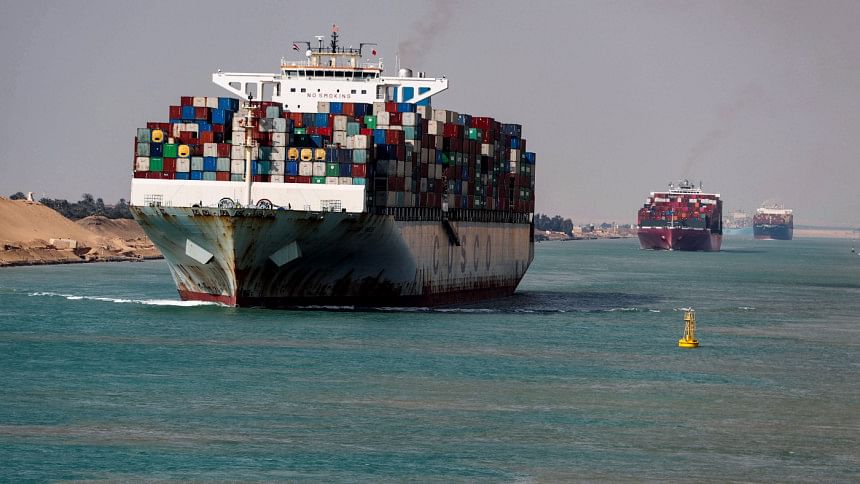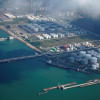Oil investors are adrift in Red Sea rip currents

Geopolitical tensions in the Middle East aren't registering with the oil market. Two years ago this month, the price of a barrel of Brent crude rocketed 30 percent to $120 in the aftermath of Russia's invasion of Ukraine.
Yet four months after the conflict between Israel and Gaza started, the black stuff is bumping along at around $80 a barrel – lower than before the fighting started in early October. Investors' eerie calm reflects expectations of weak demand, ample supply, and lax US sanctions on Iran. All three could change.
The world is in a different state than in 2022, when surging growth after the Covid-19 pandemic left oil supply extremely tight. Prices were already above $90 a barrel before Russian President Vladimir Putin launched his invasion.
The global economy had grown by 6 percent in 2021 and the Organization of the Petroleum Exporting Countries and allies including Russia – collectively known as OPEC+ – was still unwinding output cuts of almost 10 million barrels per day it had introduced in 2020. The prospect of 5 million barrels of daily Russian crude supply, disappearing from the market sent prices spiking.
By contrast, the oil market today looks oversupplied. The World Bank expects, the global economy will only grow 2.4 percent this year, while the International Energy Agency reckons demand for oil will expand by just 1.2 million barrels per day – half last year's increase.
Meanwhile, the IEA reckons, global supply will grow by 1.5 million barrels a day, thanks to hyperactive producers who are not part of Opec+, particularly the United States.
The market also has a built-in pressure-release valve. OPEC+ countries like Saudi Arabia have collectively been pumping about 5 million fewer barrels of oil a day than they could to try to prop up prices. If there was disruption to the market, US President Joe Biden could lean on Saudi Crown Prince Mohammed bin Salman (MbS) to open the taps.
Attacks on shipping in the Red Sea by Houthi militants from Yemen disrupt that delicate balance. The strikes have made it much riskier for ships to pass through the Suez Canal, the quickest route to Europe. Oil tankers which travel around the bottom of Africa will arrive two weeks later than planned.
They will also burn more oil by either sailing for longer or speeding up to recover lost time. Diverting oil tankers around Africa uses up an extra 200,000 barrels a day, an oil expert told Breakingviews, pushing the growth in oil demand this year to 1.4 million barrels a day.
Moreover, the IEA's growth projections may be wrong. OPEC reckons extra demand in 2024 of 2.25 million barrels a day, due to a surge in buying by petrochemical refiners in China and the Middle East. That's way above the expected rise in non-OPEC supply. An uptick in global GDP growth, perhaps stimulated by lower interest rates in the United States, would also boost oil consumption.
Finally, there's Iran. Sanctions on the export of the country's oil, imposed by Biden's predecessor Donald Trump, remain in place. But enforcement of the curbs has been lax.
Iran's oil exports have increased from under 500,000 barrels a day in 2020 to nearly 1.5 million barrels a day, according to Vortexa data. The $62 billion of oil and gas revenue the IEA estimates that the country generated in 2022 gives Tehran extra firepower to finance its proxies in the "Axis of Resistance" around the Middle East – including the Houthis.
Ahead of a US presidential election in which petrol prices will play a role, Biden will be loath to risk raising costs for American drivers by squeezing Iranian exports. But pressure from opposition Republican politicians might force his hand.
The US has already launched airstrikes against the Houthis and Iranian proxies in Syria and Iraq, after attacks Washington claims were responsible for the deaths of three US servicemen. Tensions between the US and Iran could escalate further.
As ever, Saudi Arabia has a decisive role to play. MbS may see the logic of aiding Biden by helping to control the oil price. Yet the kingdom's de facto leader has had his differences with the US president. He may prefer a return of Trump, who took a milder line on controversies like the killing of journalist Jamal Khashoggi by Saudi agents in 2018.
Even if Saudi does help, it cannot guarantee a calm Middle East. Tehran, which despite recent Chinese-brokered talks is perpetually at odds with Riyadh, might be enraged if stricter US sanctions blocked it from Asian markets. I
n 2019, rocket attacks, on Saudi's key refinery at Abqaiq briefly knocked out around 50 percent of the kingdom's oil supply. Iran denied involvement, but the strikes occurred the last time its oil was tightly sanctioned.
The biggest risk is that Iran plays its trump card and blocks the Strait of Hormuz, the narrow stretch of water that lies between the Arabian Gulf and the Gulf of Oman, which is the conduit for around 21 million barrels of daily oil, over a fifth of world consumption.
That would imperil around four times the amount of supply initially feared to be at risk from Russian sanctions in 2022. And it would almost certainly push prices far above $100 a barrel.
Such an extreme outcome is unlikely. Indeed, matters could equally take a more positive turn. Israel and leading Western states are currently engaged in protracted talks about a ceasefire in Gaza, mediated by Qatar. If successful, Hamas would progressively release over 100 Israeli hostages, in return for a cessation to hostilities likely to last months.
After that, Israeli Prime Minister Benjamin Netanyahu would probably come under pressure from both Western and Arab leaders not to restart the war. A more permanent truce could prompt Saudi Arabia and allies to formally recognise Israel as a state – key to easing tensions in the region.
Still, these talks aren't certain to succeed, and towards the end of January investors started to markedly increase the proportion of bets made on oil prices rising rather than falling via the futures market. The current surprising calm may precede a storm.

 For all latest news, follow The Daily Star's Google News channel.
For all latest news, follow The Daily Star's Google News channel. 







Comments